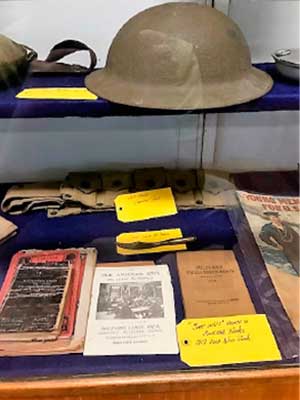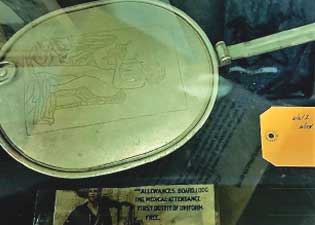This war, more commonly known as the First World War, has often been described as the war to end all wars. With over 18 million deaths it is easy to understand why that phrase is often quoted.
Today, on the second floor of the museum, there are display cases containing artifacts from the Civil War, Indian Wars of 1870s, Spanish American War, and First World War. These artifacts, now just over 100 years old, represent the equipment the American soldiers brought to France in 1917, when we finally joined forces with the Brits and French who had been fighting for 3 long brutal years.
The case contains a helmet made of steel which was issued when they first got to France. Nothing fancy — troops called it a soup bowl, nothing like our present day helmets. It had a leather chin strap and insulation which helped snug it up on ones head. Very little protection and most of your lower head was exposed. Twenty years later this same helmet was issued to troops in the South Pacific prior to WW2.
Below the helmet is a canvas cartridge belt issued to each man going into combat. He carried stripper clips of 5 rounds each. And as many as he could fit in each pouch. The rifle was a Springfield 1903 bolt action rifle caliber 3006 which was made by Springfield Armory. Plus a large bayonet almost two feet long. It could be used to attach canteens, medical kits, and more.
Another important item was the mess kit. The mess kit was a very simple item which came with plate, cup, spoon, fork, and knife. Some of the other things which troops did to take up time in the trenches was trench art. They would take empty shell casings and create decorative art work such as a bullet with a piece of brass inserted. Looks like it was a letter opener. Dated 1917, if only it could talk.
Surprisingly, the troops were issued books on how to translate English to French. And a small soft cover book of places to see in and around Paris if you were lucky enough to get back from the front lines. There is a book printed by the U.S. Military on infantry tactics dated 1917. This was given to each man as he entered the Army.
The items listed above and more can be seen at the Canton Historical Museum’s second floor exhibit of military articles. Many items are still out there to be collected and it can turn into an interesting hobby.


